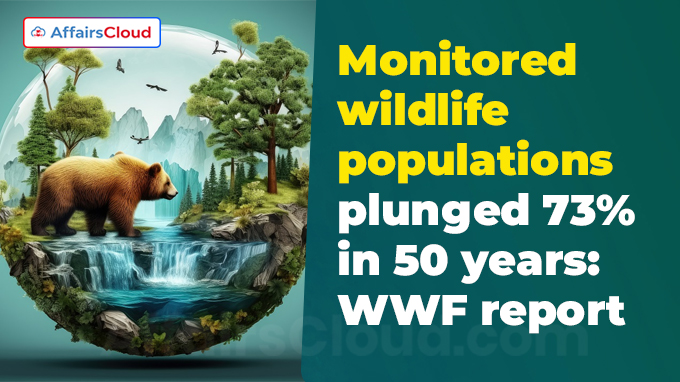 The World Wide Fund for Nature(WWF) released the 15th edition of its biennial assessment ‘2024 Living Planet Report- A system in Peril‘ stating that the average size of monitored wildlife populations has decreased by 73% in just 50 years (1970-2020).
The World Wide Fund for Nature(WWF) released the 15th edition of its biennial assessment ‘2024 Living Planet Report- A system in Peril‘ stating that the average size of monitored wildlife populations has decreased by 73% in just 50 years (1970-2020).
- The WWF uses the Living Planet Index (LPI), provided by ZSL (Zoological Society of London), to track wildlife population trends, covering nearly 35,000 populations of 5,495 species from 1970 to 2020.
- The report emphasizes that urgent action is needed over the next 5 years to address the serious climate and nature crises as the Earth nears critical tipping points that threaten humanity.
Highlights:
i.The steepest declines in wildlife populations are in Latin America and the Caribbean (95%), Africa (76%), and Asia-Pacific (60%).
- Pollution significantly impacts populations in Asia and the Pacific.
ii.The highest decline is reported in freshwater ecosystems (85%), followed by terrestrial (69%) and marine (56%).
iii.The major threats to wildlife include habitat loss and degradation due to food systems, followed by over-exploitation, invasive species, and disease.
iv.In India, populations of three vulture species have drastically declined: the white-rumped vulture by 67%, the Indian vulture by 48%, and the slender-billed vulture by 89% since 2002.
- Despite these declines, some wildlife populations in India have stabilized due to government initiatives, effective habitat management, and community engagement.
v.India now hosts the largest population of wild tigers globally, with an estimated 3,682 tigers as of the All-India Tiger Estimation 2022, up from 2,967 in 2018.
vi.The Ministry of Environment, Forest & Climate Change (MoEF&CC) recently conducted the first Snow Leopard Population Assessment in India (SPAI), estimating the population at 718 across 70% of their potential range.
Key Points:
i.Declines in wildlife serve as early indicators of extinction risk and ecosystem health.
ii.Potential tipping points like the Amazon rainforest dieback and coral reef die-offs could disrupt food security and livelihoods globally.
Recent Related News:
i.According to International Labour Organisation (ILO)’s report titled “Global Employment Trends (GET) for Youth 2024: Decent work, brighter futures”, Global Youth Unemployment Rate (YUR) in 2023 decreased to 13% which represents a 15-year low and a fall from the pre-pandemic rate of 13.8% in 2019.
ii.According to the World Economic Forum’s (WEF) report “Income Protection and Early Warning Systems: How India is Building Climate Resilience”, India lost 33.9 million hectares (ha) of crops due to excess rains and an additional 35 million ha due to drought during 2015 to 2021.
About World Wide Fund for Nature (WWF):
President & Chief Executive Officer (CEO)– Carter Roberts
Headquarters– Gland, Switzerland
Established -1961




